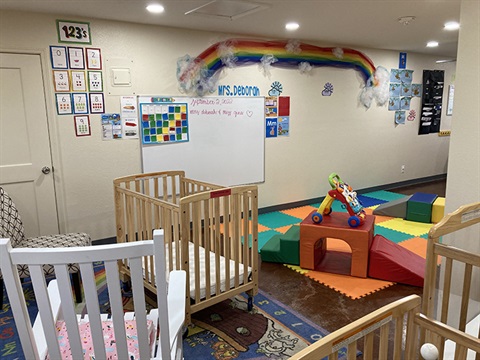Childcare, Adoptive & Foster Care Inspections

The Environmental Health Division conducts annual sanitation inspections of licensed childcare facilities to ensure a healthy environment for children. These inspections follow the guidelines established by the Texas Health and Human Services Commission, Department of Family and Protective Services, Child Care Regulatory Services Division. Inspections of foster and adoptive homes are performed upon request.
Inspections of foster and adoptive homes are performed upon request.
Inspection Application(PDF, 264KB)
Child Care Centers
During a childcare facility inspection, sanitarians focus on ensuring children are in an environment that prioritizes their health and safety. The following standards are held during a childcare center inspection:
- Buildings, grounds, facilities, toys, and furniture are inspected for cleanliness, proper repair, and absence of safety hazards.
- Drinking water is readily available, served in a safe and sanitary manner, and comes from a TCEQ-approved source
- Adequate lighting, ventilation, and heating are provided.
- No evidence of pests, insects, rodents, or stray animals, and preventative measures are in place to keep buildings, grounds and facilities free of pests, insects and rodents. If chemicals are used, they are applied by a pest control company
- All garbage and trash are inaccessible to children, stored in containers with lids, and removed as necessary to maintain sanitary conditions and prevent nuisances, inside and outside the buildings.
- Adequate and safe flushing toilets that are properly equipped, maintained, repaired, and supplied.
- Sewage and wastewater disposal into public sewer or onsite sewage facility are approved by TCEQ or local authorized agent.
- Children and staff wash their hands correctly and as often as necessary, and gloves available for diaper changing.
- A hand-wash-only sink is available in the diaper changing area and other convenient areas for adults and children with supplies. Water temperature supplied to children does not exceed 120° F.
- Diapering facilities are equipped, clean, disinfected, and in good repair with gloves available. Correct diaper changing procedures are demonstrated.
- Cribs, toys, highchairs, tables, laundry, sleeping equipment, potty chairs, restroom surfaces, including toilets, water play tables, wading pools, diapering areas, kitchen equipment, dishes and utensils are all washed and sanitized.
- All food and drinks must be from an approved source and need to be prepared, distributed, served, and stored is a sanitary manner. If meals are prepared on site, they need to comply with the Texas Food Establishment Rules and Food Code.
- Cleaning supplies, chemicals, medications, and other toxic substances are stored properly, separate from food, and inaccessible to children. Containers and spray bottles properly labeled.
- Areas for children are free of safety hazards including safety precautions, guards, and barriers for electrical and 220 volt outlets, fans, heaters, air conditioners. Glass doors marked at children’s eye level. No toxic materials or poisonous plants.
- Containers and bodies of water are inaccessible to children.
- Animals are vaccinated and treated, and animal areas are kept safe and clean. No stray animals. Vaccination records available for verification.
- Swimming pools are maintained and fenced with the correct water quality.
- No smoking within the facility by any persons.
Foster & Adoptive Homes
The following check points are reviewed during an inspection for foster and adoptive homes:
- Home and yard are clean, maintained, repaired, and free of hazards to children. Toys, furniture, equipment for children’s use are safe and sturdy.
- Kitchen, food storage, and serving areas clean, in good repair. Single service items used only once.
- All food safely stored. Refrigerator temperature 40° F or colder. Foods stored in covered containers and off the floor. Thermometers available (recommended) for refrigerator and cooking.
- Water supply (public or private) meets standards of the Texas Commission on Environmental Quality.
- Home connected to sewer or onsite sewage facility. No nuisances from improper sewage disposal.
- Plumbing appears to be in good working condition. Hot and cold running water supplied to lavatories, tubs, and showers. There is at least one toilet, lavatory, and bathtub or shower inside the home.
- Bathrooms are clean. Soap and toilet paper available in the bathrooms at all times. Each child has a clean towel available, or paper towels are available.
- Storage space is available for each child’s clothing and personal belongings.
- Garbage removed at least once a week. Garbage kept in containers with tight fitting lids away from children. The yard is kept free of garbage and trash.
- The home and yard is kept free of insects, mice, rats, and stray animals.
- Animals and pets vaccinated and treated by a veterinarian. Animal areas are kept clean.
- The yard is well drained with no standing water. No mosquito breeding conditions.
- Bodies of water, containers of water, swimming pools and spas are inaccessible to children without supervision. Fences, locks, barriers, etc. are provided.
- Home is adequately ventilated. Free from bad odors. Windows and doors for ventilation are screened.
- Cleaning supplies, pesticides, medicines, chemicals; flammable materials, weapons, poisonous plants, etc. stored inaccessible to children. Containers clearly labeled and stored separate from food.
- Electric outlets in rooms accessible to children have childproof covers. Electric fans, air conditioners, heaters, 220-volts connections are securely mounted, provided with screens or guards, and/or kept out of reach of children whom these items might present an unusual danger.
- Indoor and outdoor steps, floors, and walkways are safe and not slippery. Porches, railings, playhouses, other wooden structures, wood surfaces and objects do not have splinters.
- Glass doors are marked at a child’s eye level to prevent accidents.